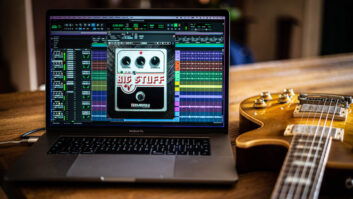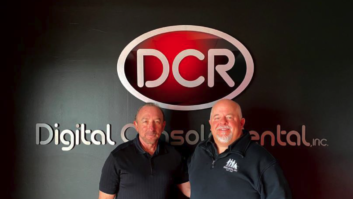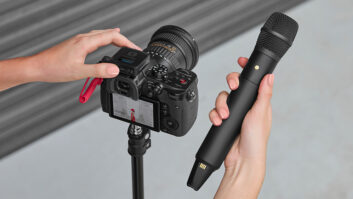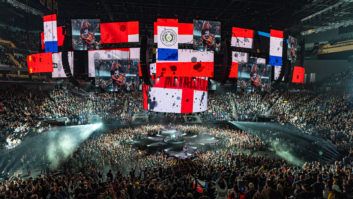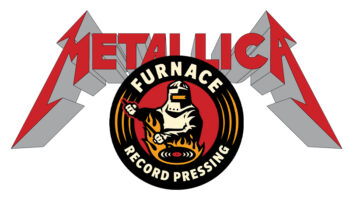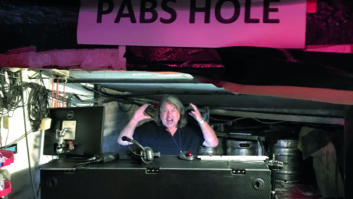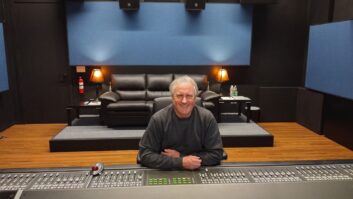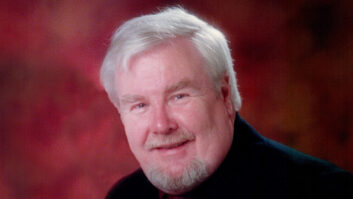The Engineers tell all on how Metallica’s sound has changed during the years:
Paul Owen: “We’ve become older and wiser over the years. Metallica is a really different entity than any other bands. When they do tour, they probably tour in a harder fashion than anybody else does. I mean, within any given week, you could be doing a stadium, a club date, a TV show and back into a stadium, and you have to be prepared to change with all of those different aspects of live venues.
“Metallica is pretty unique in the point that instead of just your average format of a four-piece band—drums, guitars and a bass—they actually push the envelope quite a bit in what can be done with a band, with regards to configuration of where they play. They’ve probably done the most unique stage sets—arenas in the round—and even just playing with an orchestera. Just stepping up and giving you those challenges straightaway.
“The orchestra was an idea in the making for a long time. It was an interesting project to be involved with: from the recording to the two live shows we did in Madison Square Gardens and Berlin. That was the first time that Thunder Audio got involved—the first time I supplied a system—and now I’ve been involved all the way through.”
Big Mick: “A lot. I started with them when they were in clubs, theaters and we’d go around and bombast everyone on the bus; very few crew. And it just grew. You could see where this band was going, because a lot of people would come to see the show. It just got bigger and bigger: theaters and half-arenas, supporting Van Halen and Scorpions on the Monsters of Rock in 1980-something. We went around to stadiums. They just roared; they were young. And it just went on.
“But Metallica is not like any other band. I’ve done Def Leppard, Ozzy Osbourne, a lot of other bands. Metallica is more of a concept sound than it is just a rock ’n’ roll thing. You know, when you do these other bands, it’s quite straightforward—you’ve got your kick, snare hat, tom, bass guitars, guitars—and everybody plays; and when somebody plays a solo, everybody else backs off and lets the solo happen and then come back in again. That’s not the way Metallica’s music is. When Kirk plays a solo, it kind of signals everybody else to get going. So you have to filter things in and out a bit, control the mix, just sit on top of it all. It’s kind of interesting. I’ve been doing this for 20 years and it’s been quite a ride.
Big Mick on formulating Metallica’s sound:
“Like the click of a kick drum, I think we started that. And I did that—something Lars had no idea about—solely because you could never hear when he was playing double bass drum. So you have to have the click in the kick drum in order to hear it. And then, of course, you have to moderate the amount of low end to go with that so that the click doesn’t sound so obnoxious. Because if you just have all click, it sounds like a typewriter and not a double bass drum. So we started finding that the bass drum needed to have a bit more of a pointy edge to it—to hear it more upfront.”
So we formulated that and it worked out really well and we’ve gone through doing different things over the years: modifying guitar sounds so they worked together. We go to Boogies, instead of Marshall, done an awful amount of work on microphones.”
With a lot of heavier-sounding acts, it is very difficult to get cymbals heard. Years ago, I just couldn’t get the cymbals heard. So if I got the cymbals to where they were loud enough, I had too much guitar across them, as well; you’d have a lot of everything across them. And it was really ugly. So you kind of go along with what everybody else was doing for a few years—you put in mics over the top and trying different ones and trying to get rid of all the spill—and it still never really worked. So then Zildjian came out with this little thing called the ZMC1, and it was a little tiny microphone sensor and it was a little square box that clicked under the cymbal. Except it clicked to the cymbal stack, which proved to be right in the center of any cymbal, so every cymbal sounded like a gong. You couldn’t hear the stick hit the cymbal; all you could hear was this big ‘whooshing’ sound like a gong.”
So that didn’t really work, but the idea was really good that you had a mic for a cymbal and it came with this little rackmount mixer. It had all of these knobs on it for volume, there was no tone control. And I thought that I could do this better. So what I did then was I miked every cymbal from underneath and I started by using Shure SM98s and now I use the Audio-Technica 3525, the little gooseneck ones. And I extend the gooseneck so it goes further to the edge of the cymbal so the actual overhead mic sits as one per cymbal and it sits nearer to the edge than it does to the center so you can get the stick hitting the cymbal noise, and then I can position it in the mix left and right. It’s just that the mic is so close to the source that there is very little gain on them so you tend to just get cymbal and a considerable amount of snare drum, which doesn’t hurt. So we did the kick drums and overheads.”
For James’ clean sound, we use a Roland JC120, which I mike in stereo to 4050s, panned left and right, and that’s a huge sound. That has always been absolutely stunning. But then of course, as you start acquiring more microphones onstage, you start to get a cumulative noise problem. You end with like four guitar mics on one side and two on the other. So then I decided it was time to seal the microphones in cases, this was probably 12 years ago. I don’t think anybody was doing it; it just made sense to me. So I put the guitar mics in a flight case and shut the lid, but then I left it backstage somewhere, and it worked really well. So we have an awful lot of those now since I can’t afford to buy isolation chambers. “
Metallica’s digital audio engineer Mike Gillies on using an SNS A/V SAN in the studio and on the road:
“For the St. Anger [Metallica’s latest album] sessions, not one bandmember showed up to the studio with a single riff or lyric written. They would jam out for hours, sometimes for eight- to nine-hour sessions, and anytime anyone had an instrument in their hands, I recorded it. Then we went through and found the little bits that we liked, looped them and that’s how the songs were written. This just isn’t the way records are made, and there is no way this could be done before the Fibre Channel technology of the A/V SAN.
“This will give an idea of how much data we’re talking about. Just the cross-fades alone on some sessions were 12 to 13 Gigabytes, and all told, we totaled over 2.5 Terabytes and more than 1 million files. I never lost a single bit of data, no drive ever went down and I never had one DAE error. We even found the finite end of Pro Tools, which stopped at about 13 hours on a 44.1kHz, 24-bit session. One of the most powerful pieces of recording software quit before the A/V SAN.
“The unit is out on tour so that I can quickly turn over live tracks to radio stations that want cuts from the festival shows. As opposed to renting several expensive 8-track tape machines that require synching and archiving large amounts of tape, I can run 48 tracks directly into the A/V SAN, where I can quickly recall a given song and prepare it for radio airplay. This had to be 100 percent reliable. You simply can’t have a hard drive drop in a live recording situation. You can’t have the band play anything again live, so your system has to be able to handle long, 48-track programs, which I knew the A/V SAN could.”
